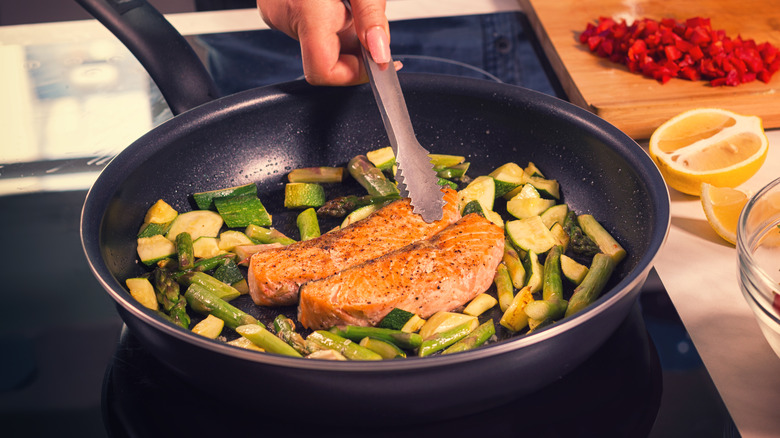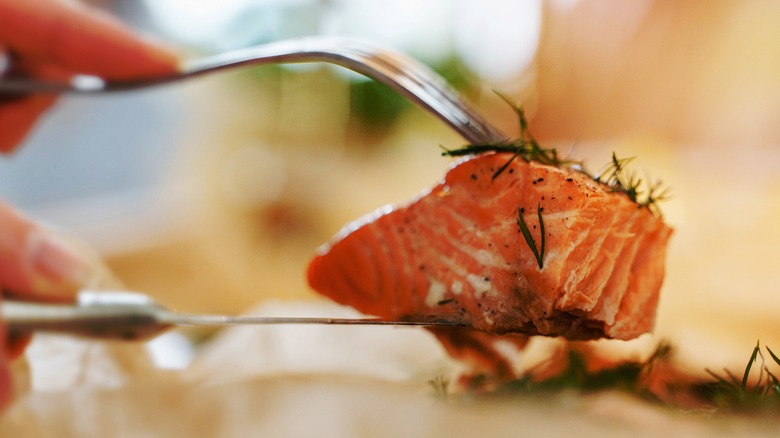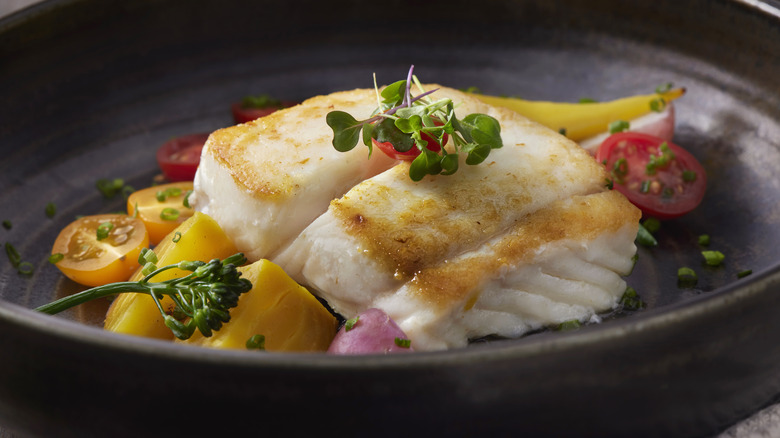The Knife Trick That Lets You Know When Fish Is Perfectly Cooked
A well-cooked piece of succulent flaky fish is a beautiful thing, but the narrow margin of timing it takes to get it just right can intimidate many home cooks. Taking it out of the oven or pan just a minute early can result in an unpleasantly chewy piece of undercooked protein, whereas too much time on the heat can turn it dry and rubbery. To help you avoid this common mistake everyone makes when cooking salmon and other fish, you can use a simple butter knife.
While cutting the fish open is one foolproof way to see how done it is on the inside, it also messes up the presentation — not ideal, especially if you're serving it to guests. But you can use a knife in another way instead. Just take a butter knife and slide it gently into the fish at the thickest part. You then can carefully nudge the filet apart to check if the interior looks opaque, or feel how warm the knife is by holding it against the sensitive skin of your bottom lip. If it feels warm, your fish is likely done, but a cool temp indicates that it needs more time.
The USDA recommends cooking all fish to a minimum internal temperature of 145 degrees Fahrenheit, and this can only be judged accurately with a thermometer. But by using this knife trick, plus a few extra tips, you can still successfully gauge if it's cooked to your liking.
Use a butter knife to check the temperature of fish
The flat, curved shape of a butter knife preserves the appearance of a fish filet well, but you want to use some finesse, too. Insert the knife along the natural seams within the fish, or at a 45 degree angle, and be careful and steady-handed to maintain the structure of the filet. Hold the tool within the fish for three to five seconds before checking, to make sure it has time to pick up the internal temperature.
If you'd rather not use a utensil as large as a knife, for fear of the flesh breaking, try Eric Ripert's skewer tip to tell when fish is done cooking. The similar technique involves poking the skewer in the fish and holding it for five seconds, and then touching it against your wrist to check that it's warm. Alternatively, you could use a cake tester. With a perfectly cooked piece of fish, your knife or skewer should glide through the flesh smoothly, without resistance.
Once fish is overcooked, there is nothing you can do to rescue it. Check it early in the cooking process and as often as you can, as the meat can cook incredibly quickly. Generally speaking, fish will flake more easily as it cooks and the flesh will turn more opaque, so if it's translucent or overly firm, give it extra time.
More tips for cooking fish evenly every time
Beyond testing the doneness of your fish, you can take extra steps to make sure it turns out perfectly-cooked and delicious. Firstly, don't make the oven or pan too hot, as this can risk an uneven cooking job, where the exterior of the fish cooks quickly but the interior remains undercooked. Keep the heat too low, though, and the texture can become soggy. A medium temperature will achieve more even cooking throughout.
If you want to saute a filet so it gets a good color, you can start by cooking it in a hot pan, but consider finishing it in a warm oven so that the inside can reach the desired doneness more slowly. Bear in mind that there will be some carryover cooking, i.e. the fish continues to cook even after it's removed from the heat. Take it off when it's just shy of the doneness you're aiming for, and let it rest so the juices can redistribute and increase its succulence — because Anthony Bourdain's crucial step for perfect steak also applies to fish.
Of course, you may prefer different types of fish cooked to a greater or lesser extent. Tuna, for example, is juicy when it's still pink within, and can dry out if cooked through. Likewise, you may want salmon cooked to medium, but cod more well done. Balance personal preference with safety, and use your senses plus some simple tools to help guide you.



